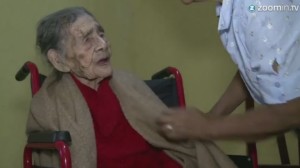Aging

Leandra Becerra Lumbreras, born in northeast Mexico, claims to have been born on Aug. 31, 1887 – meaning she turned 127 on Sunday and that would make her the oldest human being ever on the face of the earth. She is still able to chat and has some mobility despite her deafness and severe cataracts, EFE reports.
She celebrated her birthday over the weekend in the company of some of her 153 descendants. They made sure she got enough rest and was awake for the event: these days this witness to three centuries usually sleeps in 72-hour periods, relatives say.
My dad, Andrew Frank Hatch, will be 116 next month, so living a long life is something I know a little something about. People often ask the much repeated question, “How does he do it?” My father always says his longevity is due to the man upstairs and I will add that having loving family is the next important ingredient. I hope you enjoy this article endorsed by the National Institute of Aging that can perhaps shed light on the aging process.
Just like millions of Americans, the National Institute on Aging’s (NIA) Baltimore Longitudinal Study of Aging (BLSA) celebrates its 50th birthday in 2008. The study was the first to ask a most basic question: What is normal aging?
There is still much to learn, but so far two major conclusions can be drawn from BLSA data. First, “normal” aging can be distinguished from disease. Although people’s bodies change and can in some ways decline over time, these changes do not inevitably lead to diseases such as diabetes, hypertension, or dementia. A number of disorders that typically occur in old age are a result of disease processes, not normal aging.
Second, no single, chronological timetable of human aging exists. We all age differently. In fact, in terms of change and development, there are more differences among older people than among younger people. Genetics, lifestyle, and disease processes affect the rate of aging between and within all individuals.
These fundamental changes in our thinking about age and disease have led the BLSA and the field of aging research in important new directions. As we further pinpoint the influences on how we age, we can also think about new and more effective interventions that may prevent disease and promote healthy aging.
You can find the complete BLSA booklet at this website http://www.nia.nih.gov/sites/default/files/healthy_aging_lessons_from_the_baltimore_longitudinal_study_of_aging.pdf
– Healthy Aging: Lessons from the Baltimore Longitudinal Study of Aging
